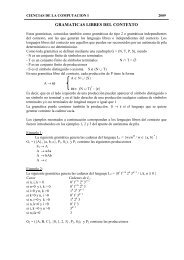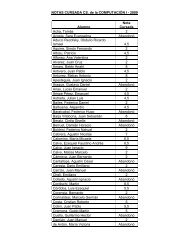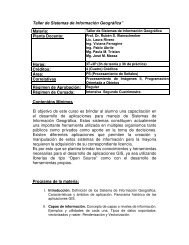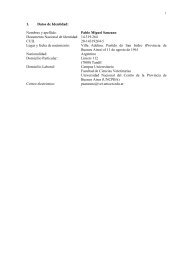Libro de Resúmenes / Book of Abstracts (Español/English)
Libro de Resúmenes / Book of Abstracts (Español/English)
Libro de Resúmenes / Book of Abstracts (Español/English)
Create successful ePaper yourself
Turn your PDF publications into a flip-book with our unique Google optimized e-Paper software.
Resumenes 24<br />
X<br />
µ<br />
⎧<br />
⎪<br />
⎪ dX<br />
⎪<br />
⎪<br />
dt<br />
⎪<br />
: ⎨<br />
⎪<br />
⎪<br />
⎪ dY<br />
⎪<br />
⎪ dt<br />
⎪<br />
⎩<br />
⎛<br />
= r⎜1<br />
−<br />
⎝<br />
X<br />
K<br />
⎛ αX<br />
⎞<br />
q ⎜ X − ⎟<br />
⎞ ⎝ X + β<br />
−<br />
⎠<br />
⎟ X<br />
Y<br />
⎠ αX<br />
X − + a<br />
X + β<br />
⎛ ⎛ αX<br />
⎞ ⎞<br />
⎜ p⎜<br />
X − ⎟ ⎟<br />
⎜ ⎝ X + β ⎠ ⎟<br />
= ⎜<br />
− c ⎟ Y<br />
αX<br />
⎜ X − + a ⎟<br />
⎜<br />
⎟<br />
⎝<br />
X + β<br />
⎠<br />
8<br />
con µ = ( r , K,<br />
q,<br />
a,<br />
p,<br />
c,<br />
α,<br />
β ) ∈ ℜ+<br />
, don<strong>de</strong> Y = Y() t representa el tamaño<br />
poblacional <strong>de</strong> los <strong>de</strong>predadores para t ≥ 0 y los parámetros, todos<br />
positivos, tienen diferentes significados biológicos.<br />
El sistema obtenido es <strong>de</strong>l tipo Kolmogorov [Freedman 1980], y se<br />
<strong>de</strong>termina una región <strong>de</strong> invarianza, los puntos <strong>de</strong> equilibrios, estableciendo<br />
la naturaleza <strong>de</strong> cada uno <strong>de</strong> ellos y se obtienen condiciones en los<br />
parámetros para la existencia o no <strong>de</strong> ciclos límites.<br />
La importancia <strong>de</strong>l estudio <strong>de</strong>l uso <strong>de</strong> refugio por parte <strong>de</strong> las presas<br />
es relevante en los proceso <strong>de</strong> conservación <strong>de</strong> especies en peligro <strong>de</strong><br />
extinción con la creación <strong>de</strong> reservas (refugios) para preservarlas<br />
[Srinivasu and Gayitri 2005]<br />
Dinamics in the Rosenzweig-McArthur predation mo<strong>de</strong>l<br />
consi<strong>de</strong>ring saturated refuge for prey.<br />
Commonly in Population Dynamics it is affirmed that prey refuge use<br />
has a stabilizing effect in system when <strong>de</strong>terministic continuous-time<br />
mo<strong>de</strong>ls for predator-prey interactions are employed [Collings 1995,<br />
Maynard-Smith 1974, Ruxton 1995, Sih 1987].<br />
If X = X(t) represents the prey population size, this affirmation it is<br />
possible to verify, <strong>de</strong>scribing the interaction with the Lotka-Volterra mo<strong>de</strong>l,<br />
and assuming that the quantity <strong>of</strong> prey in cover Xr is proportional to<br />
population size , that is X r = α X , or else, the quantity <strong>of</strong> population at<br />
refugia is constant., i. e. X r = β [Harrison 1979, Taylor 1984].<br />
When the predator-prey interaction is <strong>de</strong>scribed with by the wellknown<br />
Rosenzweig-McArthur mo<strong>de</strong>l [Murdoch 2003, Turchin, 2003], in<br />
González-Olivares and Ramos-Jiliberto, (2003) was <strong>de</strong>monstrated that for<br />
certain parameter constraints, the effect <strong>of</strong> refuge by a fraction <strong>of</strong> prey<br />
population implies oscillatory behavior due the apparition <strong>of</strong> limit cycles on<br />
system.<br />
At once, Ruxton [1995] constructs a mo<strong>de</strong>l assuming that the rate in<br />
which prey move to refuge , is proportional to predator <strong>de</strong>nsity, that is,<br />
= λ y , and it is prove that the refuge has a stabilizing effect.<br />
X r


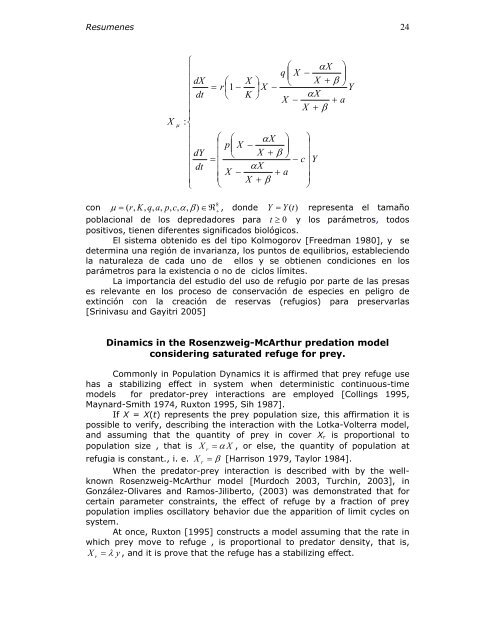
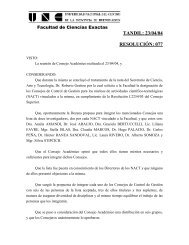
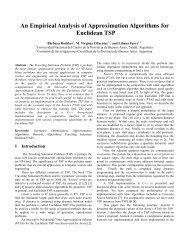
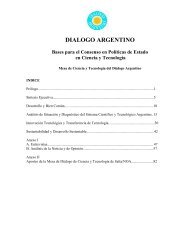


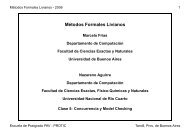
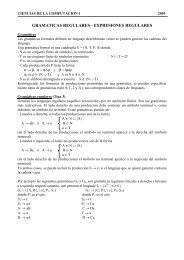

![Clase 13 [pdf]](https://img.yumpu.com/19616969/1/190x245/clase-13-pdf.jpg?quality=85)

